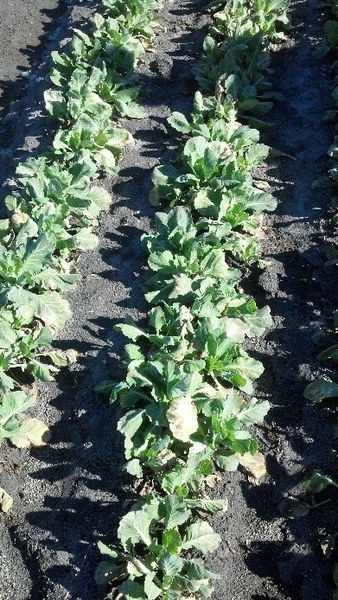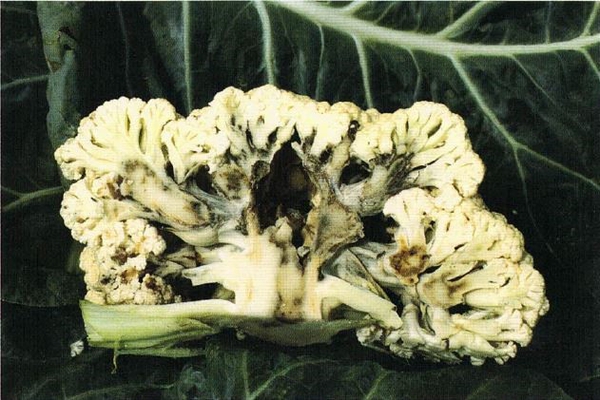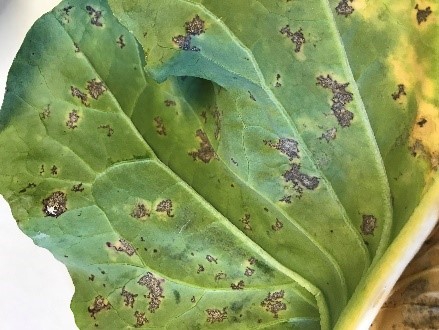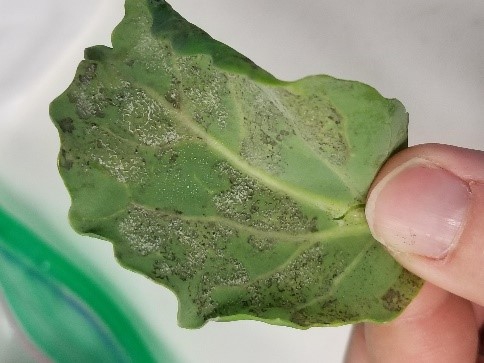Introduction
Downy mildew is a foliar disease that affects brassica crops worldwide. The disease can be especially damaging to seedlings, but can also reduce yield at later growth stages. The disease is favored by cool (50 to 59ºF), wet weather.
Pathogen
Downy mildew on brassica crops is caused by the oomycete (fungal-like organism) Hyaloperonospora parasitica.
Host Plants
This disease is common on cabbage, Brussels sprouts, cauliflower, broccoli, marrow-stem kale, and kohlrabi. Chinese cabbage, turnip, turnip rape, arugula, oilseed rape, rutabaga, brown mustard and Oriental mustard, black mustard and Abyssinian mustard are also hosts. Other plants that may be infected include radish, horseradish, yellow mustard, wild mustard, watercress, stock, wallflower, aubretia, and other crucifers.
Symptoms and Signs
Symptoms on seedlings include discolored lesions on the cotyledons that turn into necrotic spots. Symptoms on older leaves appear as small, angular, light green to yellow lesions on the upper leaf surface. The lesions enlarge with the development of disease and form irregularly-shaped necrotic patches. On the undersurface of the leaf, gray to white masses of spores will develop (“downy” growth). Under favorable conditions, both sides of the leaves may be covered with spores (sporangia and sporangiaphores). A hand lens may be required to confirm the spores are present.
The curds of cauliflower, broccoli, and cabbage heads can be infected in the field and in storage. Pale brown to gray discoloration will appear on the surface of the curd or head, and grayish or black spots will develop on the stem beneath. The interior of the curd or head will become dark brown to black or gray under severe infection.
Downy mildew may also parasitize the taproot of turnip and radish. Symptoms may appear in storage, and include dark, discolored zones that spread from the crown into the taproot. Parasitized tissue is more vulnerable to rot.
Lookalike diseases. Other foliar diseases such as Alternaria blight, anthracnose, or bacterial leaf spot may be mistaken for downy mildew on brassica crops. Alternaria blight will be most severe on lower leaves than on upper leaves, have dark brown lesions with concentric rings, and may even split in the center of the lesion. Anthracnose will typically cause numerous small spots on leaves that eventually grow together and cause the entire leaf to die. Lesions also may split in the center. On petioles and stems, brown to gray lesions will have a black border and will be elongated and sunken. Bacterial leaf spot will also be expressed by numerous small spots, but these will have a yellow halo. On the underside of the leaf, the same spots will have a water-soaked appearance under humid conditions. It is critical to get an accurate diagnosis for the management of plant diseases.
Disease Cycle and Epidemiology
Infection of leaves and above-ground parts occurs from airborne sporangia (spores) or from water droplets that contain spores. Systemic infections are thought to arise from oospores (sexual survival structure) that germinate and infect through the root system of a young plant. After initial infection, the pathogen enters a vegetative growth stage, grows throughout the plant tissue, and produces more sporangia which cause secondary spread and infection. The organism can overwinter in the soil and on crop debris in the form of oospores. The pathogen may also overwinter on winter-sown crops or on cruciferous weed hosts. Disease is most likely to develop under cool, moist conditions when temperatures are around 50-59ºF.
Disease Management for Commercial and Organic Growers
Sanitation. Incorporate crop debris into the soil at the end of each growing season to allow the debris to decompose and to avoid creating a reservoir for the pathogen. When possible, avoid planting seedbeds near plantings of other cruciferous crops or near cull piles to reduce the risk of infecting the seedlings.
Crop rotation. Rotating to non-cruciferous crops may reduce inoculum if you have a history of disease in your field. A rotation of two to three years to a non-cruciferous crop is recommended.
Weed control. Manage weeds to eliminate alternative hosts.
Plant disease-free transplants. Obtain transplants from reputable sources and ensure that they are free of symptoms before planting.
Reduce moisture. When producing seedlings, aim to reduce moisture on the foliage in the seedbeds by limiting plant density and by irrigating as appropriate. Plant in areas where good air circulation is possible to minimize leaf wetness. Avoid the use of overhead irrigation or water at a time of day when the foliage will dry rapidly.
Plant resistant varieties. There are varieties of broccoli, cabbage, Chinese cabbage, and arugula on the market that have intermediate or high resistance to downy mildew. However, some races of the pathogen may be able to overcome host resistance, and host resistance should be employed with other practices for effective disease management.
Fungicide applications. Protective fungicides should be applied when conditions are favorable for disease development. See table below. Always read labels and take necessary precautions when applying pesticides.
|
Product name |
Active Ingredient |
FRAC |
Comments |
|
Zampro 525 SC |
ametoctradin + dimethomorph |
45 + 40 |
Do not make more than 2 sequential applications before alternating to a fungicide with a different mode of action. |
|
Ranman 400 SC |
cyazofamid |
21 |
Make applications on a 7 to 10 day schedule. Do not apply more than 39.5 fl oz/acre per crop per growing season. |
|
Forum 4.16 SC |
dimethomorph |
40 |
Do not make more than 2 sequential applications before alternating to a fungicide with a different mode of action. Do not apply to turnip greens or roots. |
|
Reason 500 SC |
fenamidone |
11 |
Apply protectively, and on a 5 to 10 day interval. Do not apply more than once without rotating to a fungicide in a different FRAC group. |
|
Presidio 4 SC |
fluopicolide |
43 |
Tank mix with a fungicide with a different mode of action. Do not make more than 2 sequential applications before alternating to a fungicide with a different mode of action. Apply no more than 12 oz per acre and make no more than 4 applications per season. |
|
Luna Sensation 500 SC |
fluopyram + trifloxystrobin |
7 + 11 |
Do not make more than 2 sequential applications before alternating to a fungicide with a different mode of action. Limit of 15.3 fl oz per acre per year. |
|
Aliette 80W DG |
fosetyl-AI |
33 |
Apply when disease first appears, then every 7 to 21 days. Do not tank mix with copper. Do not make more than 7 applications per season. Do not apply to turnip greens or roots. |
|
Revus 2.8 SC |
mandipropamid |
40 |
Apply protectively, and on a 7 to 10 day interval. Do not apply more than twice without rotating to a fungicide in a different FRAC group. Do not apply to turnip greens or roots. |
|
Varies |
Potassium phosphite |
33 |
Apply preventatively. Do not apply to stressed plants. |
|
Cabrio 20 EG |
pyraclostrobin |
7 |
Apply protectively, and on a 7 to 10 day interval. Do not apply more than twice without rotating to a fungicide in a different FRAC group. |
Disease Management for Homeowners
Sanitation. Incorporate crop debris into the soil at the end of each growing season that may serve as a reservoir for the pathogen.
Crop rotation. Rotating to non-cruciferous crops may reduce inoculum if you have a history of disease in your garden. A rotation of two to three years to a non-cruciferous crop is recommended.
Weed control. Reduce weeds around the garden to eliminate alternative hosts.
Plant disease-free transplants. Obtain transplants from reputable sources and ensure that they are free of symptoms before planting.
Reduce moisture. Plant in areas where good air circulation is possible to minimize leaf wetness. Avoid the use of overhead irrigation or water at a time of day when foliage can dry rapidly.
Plant resistant varieties. There are varieties of broccoli, cabbage, Chinese cabbage, and arugula on the market that have intermediate or high resistance to downy mildew. However, some races of the pathogen may be able to overcome host resistance, and host resistance should be employed with other practices for effective disease management.
Fungicide applications. See products in the table below. Product name may vary. Always read labels and take necessary precautions when applying pesticides.
|
Product name |
Active Ingredient |
|
Bonide Fung-onil Multi-Purpose Fungicide Daconil Garden Fungicide Ferti-Lome Broad Spectrum Landscape and Garden Fungicide Hi-Yield Vegetable, Flower, Fruit, and Ornamental Fungicide Ortho Garden Disease Control |
chlorothalonil |
|
Monterey Liqui-Cop Fungicide Southern Ag liquid Copper Fungicide Bonide Copper Fungicide Concentrate |
copper |
Resources
- The NC State University Plant Disease and Insect Clinic provides diagnostic services and control recommendations
- The NC State Extension Plant Pathology portal provides information on crop disease management
- The Southeastern US Vegetable Crop Handbook provides information on vegetable disease management
Publication date: June 9, 2021
N.C. Cooperative Extension prohibits discrimination and harassment regardless of age, color, disability, family and marital status, gender identity, national origin, political beliefs, race, religion, sex (including pregnancy), sexual orientation and veteran status.








